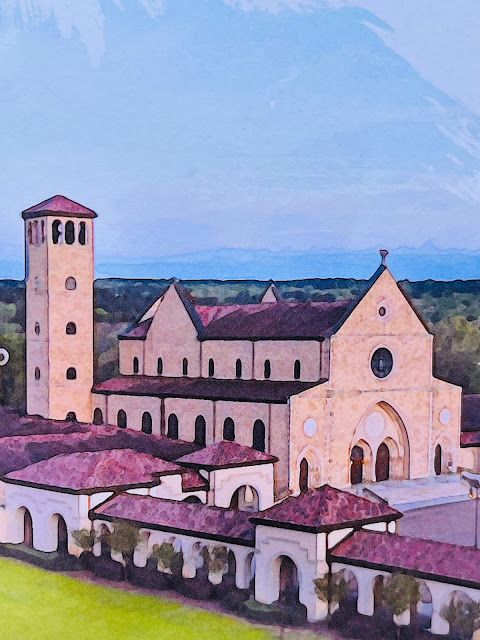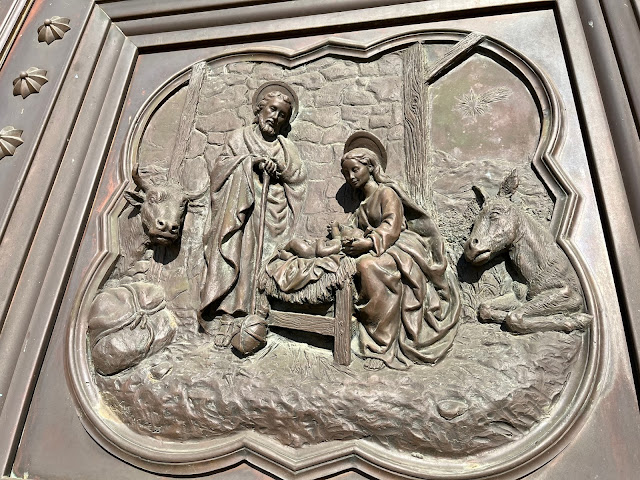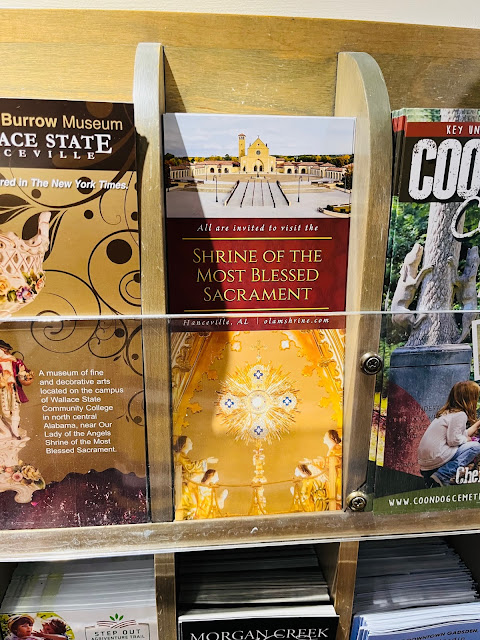 |
| Photos: Fr. Francis Mary |
The Shrine of the Most Blessed Sacrament of Our Lady of the Angels Monastery is an awesome sanctuary in the rolling hills of Hanceville, Alabama (Diocese of Birmingham). Constructed in the creative footprint of the 13th-century Basilica of St. Francis of Assisi, the Shrine has become one of the most important pilgrimage centers to visit in the US for both individuals and groups. The Shrine is informally known as the OLAM Shrine, housing the cloistered Monastery of the Poor Clare Nuns of Perpetual Adoration, the same order of Mother Angelica that has been affiliated with EWTN, the Eternal Word Television Network. While the Shrine is named in honor of the Most Blessed Sacrament, the building surroundings are dedicated to the Divino Niño, a Spanish title of the Divine Child Jesus.
The Shrine is the first of its kind dedicated to the Blessed Eucharist. It has its origins in a little-known and miraculous apparition of Mother Angelica. It is also family friendly -- not a regular tourist destination, but a pilgrimage site - the perfect destination for a summertime family road trip with the whole family. In short, it is an oasis of faith in the American south. In some ways the Shrine brings to mind the words of Christ: "Come apart into a desert place, and rest a little" (Mark 6:31).
The Shrine is a place where pilgrims can visit to honor the Blessed Sacrament, to rest their souls, to renew their faith, and to give themselves the opportunity to receive the manifest graces associated with pilgrimage. I highly recommend a visit. Pilgrims can stay here. One of the most beautiful sounds in the world is cloistered nuns in choir, chanting Holy Mass and the Divine Office. Mother Angelica was the foundress and first Abbess who lived here from 1999 until her death on Easter Sunday in 2016. She is buried in the crypt chapel of the Shrine; a further reasons why pilgrims travel here. Of Mother Angelica it was said of her in life "that none every approached her without going away better."
Mother finalized every decision of the construction, from the greatest to the smallest. Both traditional and modern building materials and techniques were used in the construction process, with some techniques being devised on sight. Mother always said the happiest day of her life was the day the Shrine was dedicated, "because I could give something so beautiful to Him." She commented that we live in a society that spends fortunes on amusement parks, shopping centers, and casinos while God deserves at least the same and more.
Also included at the Shrine is an excellent gift shop called El Niño, with all proceeds going to the Sisters. It is located inside a structure that resembles a castle, named after San Miguel (St. Michael), complete with battlement towers, and architectural features such as merlons and embrasures, sure to capture the imagination of children and adults alike. The Shrine chaplains are the wonderful Franciscan Missionaries of the Eternal Word, a community of friars founded by Mother Angelica in 1987 to be a spiritual support for EWTN. With Franciscan spirituality, their primary apostolate is prayer while providing sacramental needs at the Shrine.
The History of the Shrine Chapel
The story of the founding of the Shrine began in 1995 when Mother Angelica, the well-known foundress of EWTN (the world's largest religious television network), traveled to Bogotá, Columbia. There she visited the Sanctuary of the Divino Niño ("the Divine Child"). At the sanctuary there is a miraculous statue of the Child Jesus that attracts pilgrims by the thousands. It is a 17-centimeter high statue with arms stretched out wide with the inscription: "Yo reinaré" ("I will reign") at its base. Many pilgrims visit here to ask for healing, especially for issues of infertility.
While Mother Angelica was praying and looking up at the statue, it suddenly became alive and turned to her and spoke thus: "Build Me a Temple and I will help those who help you." Overcome with emotion, Mother pondered this experience and returned home wondering how she could fulfill this request. After searching for land for several months, her real estate agent led her to the future site of the Shrine, a former soybean field in Hanceville, Alabama. Mother Angelica visited the 400-acre site and from the moment she stepped on the property, she felt the strong presence of God. The deed for the land purchase was signed on August 2nd, the feast of Our Lady of the Angels, the patronal feast day of Mother Angelica's monastery.
To Mother Angelica, the story of the Shrine was a miracle from the beginning. "From the very start," she shared, "it was the Lord's doing - He designed it, He built it, and He paid for it." The entire edifice was paid for by 5 families who wanted their donations to remain anonymous. The interior of the church was entirely designed and built by the master architects and Spanish artisans of TAG (Talleres de Arte Granda, S.A.), a church design company located in Madrid, Spain that was founded in the 1891 and reveals in this project its customary magnificence and solemnity.
Today pilgrims flock to the Shrine to pray before Christ exposed for Eucharistic Adoration, with the memory of Mother Angelica in their hearts. She is buried in the crypt of the chapel which is open to the public. The visit lives on in the hearts of all who visit. By the experience visitors are led to a deeper love of the Blessed Eucharist and the Infant Child Jesus. The soul is refreshed and the interior life is renewed. This is exactly what Mother wanted. The Shrine was built in a few short years, consecrated on Dec. 19, 1999, on the eve of the Holy Year 2000. Not a week later Pope John Paul II opened the bronze Holy Year doors of St. Peter's Basilica on Christmas Eve, ushering in the official celebration of the Great Jubilee of the New Millennium.
The Pilgrim Experience
Constant streams of people, over 100,000 per year, enter through the bronze doors of the Shrine, experiencing the Eucharistic presence of Christ. They enter as pilgrims on a journey, greeted by their Eucharistic King, Jesus Christ the King. Visitors are touched in a profound way. No one is left unmoved. Many remark that the monstrance is the most beautiful thing they have ever seen. Photos inside the church are not permitted. There is a dress code. Silence is observed inside the chapel. Guides give explanations outside. The chapel is maintained as a house of prayer and is shared primarily as the chapel with the nuns.
Before the awesome majesty of the true presence of Christ in the Eucharist, all of the art and architecture point to the monstrance in the center of the sanctuary, evoking the true, real, and substantial presence of Christ in the Blessed Sacrament. The encounter evokes a spiritual response from the soul: to give love in return for love. A pilgrimage is thus an encounter with the living God. It is a meeting between the soul and Christ in His Eucharistic presence. This meeting of hearts inflames the soul with a desire to follow Him, for He is the Bread come down from Heaven. The entire Shrine is conducive to recollection, leaving behind the focus of what is left behind, entering to what the Lord desires to give: Himself and His love. Pilgrims ponder the transformative experience.
The Exterior of the Chapel
From a distance visitors follow a country road with two miles of white fence that leads to the Shrine entrance gate. On either side is a long river that loops around the property. Cattle, horses, and a donkey that belong to the monastery can be seen grazing on the verdure pastures. Visitors catch their first sight of the shrine, with its 110-foot bell tower that houses a carillon of 14 cast-bronze bells, 11 of which are over 100 years old (having been obtained from an older church and restored). 3 news bells were cast to complete the musical scale. In the Catholic tradition, the bells are "baptized" (blessed) and each has a name. The largest is the Divino Niño Jesús, which tolls the hours of the day and the Angelus/Regina Caeli.
In the piazza in front of the Shrine chapel, visitors enter the plaza that is the size of approximately two-and-a-half football fields (259' x 289'). English Tudor-style pavers border the piazza and colonnade. The design is a central herringbone pattern that was painstakingly laid by American and Brazilian craftsmen. Visitors are first drawn to the monument in the middle of the Divino Niño Jesús, the centerpiece of the piazza. The statue, of white marble, depicts the Child Jesus holding his loving heart made of Red Jasper in a welcoming gesture, inviting all to accept His love and imitate His childlikeness.
The reliefs on the doors, 21 in number, provide 14 meditations on the life of Our Lady. Pilgrims unite their joys and sorrows with the 7 joys and 7 sorrows of Mary. The two sets of center doors are an invitation to enter into the mysteries of the life of Christ. The Latin inscriptions above the central doors read: Virgo Septem Laetitiarum Filius Eius Pro Nobis Natus Est (Virgin of the Seven Joys, Your Son Was Born for Us"). And Virgo Septem Dolorum Filius Eius Pro Nobis Mortuus Est ("Virgin of the 7 Sorrows, Your Son Died for Us"). The intricate beauty of the doors offers a glimpse into the glory of the Lord, which fittingly shines with splendor inside the magnificent temple. The very act of opening the doors and entering the Shrine symbolizes the pilgrim's journey to open the heart, especially to the grace of healing and conversion. The two sets of minor doors off to the side of the front depict in their lunettes the two greats saints of Assisi: St. Francis and St. Clare, the founders of the Franciscan orders for men and women.
The Interior of the Chapel
Upon entering the chapel, pilgrims are awestruck by the radiant other-worldly beauty and awesome majesty of the sanctuary, with everything pointing to the Blessed Sacrament exposed for public veneration in a golden monstrance. The heart of visitors is enkindled with a feeling of entering heaven. Statues of angels kneel in adoration before the monstrance. The beauty of the sight allows for the pilgrim to refocus and give homage to Christ the King.
Side altars also of Carrara marble depict Our Lady on one and the Child Jesus on another, modeled after the Divino Niño in Columbia, South America. These altars boast exquisite mosaics also from the Tuscan village of Pietrasanta, Italy. Each altar is adorned with mosaics -- a lily surrounded by twelve stars for Our Lady and "IHS" for Christ. Both altars also have a unique golden reredos behind the altar, crafted similarly of gold-leaf in Spain.
The only visible wood seen in the chapel are the pews and four confessional boxes that are made of a rare cedar from Paraguay, South America. There is also a Gothic inspired wood entrance vestibule of the church also made of the same wood, that features a hand-carved relief of Christ the Pantocrator (a Greek title meaning "Ruler" or "Teacher").
The Basement Crypt Chapel
There is an upper church and a lower church, both reserved for silent prayer and adoration. In the upper church there is celebrated a daily Conventual Mass for the Sisters that is a daily sung Mass open to the public. Here the nuns also chant the Divine Office in common in choir. Because the upper church is a convent chapel that is also shared with the Sisters, all pilgrim services are held in the lower crypt chapel, including Masses and holy hours.
The lower chapel has various statues of great value and artistic merit, all equally remarkable in their quality of craftsmanship. The altar is of white Carrara marble with a detailed mosaic of a popular Marian monogram: AM ("Ave Maria" - "Hail Mary"). Behind the altar is a gold-leaf reredos with two hand-carved and painted statues of angels alongside a golden tabernacle. Under the tabernacle is a tracery of a quatrefoil, a Gothic and Renaissance symbol of the cross. The Gothic tabernacle is designed as a mini-Gothic church.
The basement statues include a large crucifix, a priceless work of art, along with a statue of Our Lady under the title of the Immaculate Conception, the Patroness of the United States, declared so by the unanimous applause and consent of the US Bishops and confirmed by Blessed Pius IX in 1847. Further, there are statues of St. Francis and St. Clare, the Franciscan saints of Assisi. St. Francis is depicted as meditating upon the Passion of Our Lord. St. Francis is remembered as having loved animals. These two statues are on either side of the altar.
The Nuns and Their Ministry
The Shrine is home to cloistered Sisters who freely live hidden lives behind walls separated from the world. Here they embrace the centuries-old tradition of monastic life. It is Jesus the Bridegroom who calls each one of the Sisters to be His Bride. The Sisters who dwell within the Our Lady of the Angels Monastery which adjoins the Shrine belong to one branch of the Franciscan family -- the Poor Clares of Perpetual Adoration. Their vocational call is to have a constant, hidden presence in the Shrine chapel as adorers. This enables the Blessed Sacrament to be exposed in the monstrance day and night, all through the year with sisters praying in the chapel every hour of the day.
A Thanks to Those Who Financed and Built the Chapel
If you would like to donate to the continued maintenance and upkeep of the Shrine, please give here. Meanwhile, a special thanks to the incredibly generous benefactors who built the Shrine and sustain it today, by God's grace, without whose crucial assistance this legacy would be impossible to sustain.
TAG (Talleres de Arte Granda, S.A.) of Madrid, Spain.
Brice Building Company, Inc. General Contractors in Birmingham, Alabama.
Gustav van Treeck of Munich, Germany.
Masonry Arts, Inc. of Bessemer, Alabama.
Savema, S.p.A. of Pietrasanta, Italy.
Bybee Stone Company of Ellettsville, Indiana.
Simpson Commercial Contracting, Inc. of Birmingham, Alabama.
Verdin Company of Cincinnati, Ohio.


























































